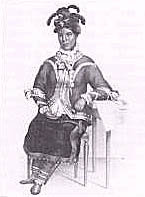Madeline La Framboise
Madeline La Framboise would have made her mark in any age, but to have done so in the period of 1780-1840 was a truly remarkable achievement. She was after all a woman and not “just a woman”, but also a Meti, an Indian-French woman. Living at the outpost of civilization on Mackinac Island, she became successful in one of the most difficult and dangerous occupations, that of a fur trader.
Each fall she and her husband Joseph left the island with their bateau loaded with merchandise to trade with the Ottawa Indians living along the Grand River. Their final destination was an area near what is now Ada, where they established a trading post. In the spring they would return to Mackinac with their harvest of furs.
After her husband was murdered in 1806, she assumed full responsibility for the family business and continued to manage several trading posts in western Michigan. Soon she was confronted with a serious new challenge when John Jacob Astor’s American Fur Company became a competitor in the fur trade. For 15 years she remained successful in competing with Astor’s powerful monopoly, but in 1818 she was convinced to merge with the American Fur Company to her financial advantage. She was acknowledged by the fur trade society, agents as well as Indians, as an intelligent worker in the trade, who was always fair in her dealings.
At the age of 41 when she retired to Mackinac Island, she was obviously a woman of intelligence and zeal who could speak four languages fluently: French, English, Ottawa and Chippewa. In spite of her fluency in speaking, she could not read or write her own name in any of these languages. Having insured the education of her own children, she recognized how important education was for the future of all the children on the island. Working with Protestant and Roman Catholic clergy, she used her money, property and influence to make education available for all children. Not surprisingly, through these efforts, she learned to read and write herself.
Her dedication to education secured for her a prominent place in Mackinac society. Now able not only to speak, but also to write in four languages, she was a resource person for all the American and European travelers and officials who came through Mackinac. It was noted by many of them that she had a very clear sense of her own identity and importance.
At her death in 1846, her remarkable achievements in the fur trade were surpassed by her efforts to educate the young. This woman of very humble beginnings left a powerful legacy in the young people she had influenced.
No picture is available for Madeline La Framboise. This portrait of an Indian woman taken in the winter of 1826-27 suggests the combination of Indian and European clothing which La Framboise might have worn.

